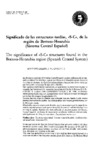Mostrar el registro sencillo del ítem
Significado de las estructuras tardías, "S-C", de la región de Berzosa-Honrubia (Sistema Central Español)
| dc.contributor.author | González Casado, J. M. | |
| dc.contributor.author | Casquet Martín, César | |
| dc.date.accessioned | 2010-01-22T13:12:31Z | |
| dc.date.available | 2010-01-22T13:12:31Z | |
| dc.date.issued | 1988 | |
| dc.identifier.citation | Cadernos do Laboratorio Xeolóxico de Laxe, 1988, 12: 243-250 ISSN: 0213-4497 | es_ES |
| dc.identifier.issn | 0213-4497 | |
| dc.identifier.uri | http://hdl.handle.net/2183/6007 | |
| dc.description.abstract | [Resumen] En el extremo oriental del Sistema Central Español, existen evidencias de un episodio tect6nico fini -hercínico, que se manifiesta en el desarrollo de una banda de 1 a 2 Km de anchura, de dirección submeridiana y buzamiento al este en la que son frecuentes estructuras de tipo «S-C» dúctiles. Esta banda probablemente extensional, se superpone a la estructura singular de segunda fase hercínica (D2), conocida como Zona de Cizalla de Berzosa (Z.C.B., CAPOTE, R. et alters, 1981; GONZALEZ CASADO,]. M., 1986), tradicionalmente interpretada como un cabalgamiento dúctil hacia el noroeste retrovergido por la fase de pliegues longitudinales D3. La zona descrita coincide además espacialmente con una banda donde existen procesos hidrotermales tardíos, los cuales podrían relacionarse genéticamente con la estructura citada. El probable episodio extensional descrito, puede relacionarse con la etapa de extensión regional generalizada que se desarrolla durante el final del ciclo hercínico en toda la cadena. Período este bien reflejado en muchos puntos del Sistema Central Español, en forma de importantes accidentes tectónicos extensionales, principalmente de dirección este-oeste y buzamiento norte o sur. | |
| dc.description.abstract | [Abstract] In the east end of the Spanish Central System there are sorne evidence of a latehercynian tectonic event. Field evidences includes the presence of «S» and «C» planes (composite planar fabrics), in a band of 1 or 2 Km of wide, with an eastwest direction and dipping to the east. This area has probable an extensional origin and has been superimposed to a structure related to the herc.ynian second phase (D2) know as the Berzosa Shear Zone (B.S.Z., CAPOTE, R., et alters, 1981; GONZALEZ CASADO, J. M., 1986). The B.S.Z. has ben interpreted as a ductil thrust towards the nort-oest, backfolded by a phase of longitudinal folds 03. The investigated region shows a spatial correlation with a band where there are sorne late hidrotermal process, what could be genetic related with the studied structure. Microstructural evidence are internally consistent with field observations. It appears that data are compatible with N-S oriented extensional detachment, dipping to the east, with and east-under-west sense of movement. This event could be correlated with a period of regional extension found elsewhere in the Spanish Central System. Developped for aH the belt during the end of the hercynian cicle. This last even is weH developped in several points of the Spanish Central System and can be seen as severa! E-W oriented detachment systems, dipping to the N and S (extensional tectonics). | |
| dc.language.iso | spa | es_ES |
| dc.publisher | Universidade da Coruña | es_ES |
| dc.subject | Tectónica extensional | es_ES |
| dc.subject | Sistema Central español | es_ES |
| dc.subject | Tardi-Hercínico | es_ES |
| dc.subject | Metamorfismo | es_ES |
| dc.subject | Estructuras S-C | es_ES |
| dc.subject | Extensional tectonics | es_ES |
| dc.subject | Spanish Central System | es_ES |
| dc.subject | Late-Hercynian | es_ES |
| dc.subject | Metamorphism | es_ES |
| dc.subject | S-C microstructures | es_ES |
| dc.title | Significado de las estructuras tardías, "S-C", de la región de Berzosa-Honrubia (Sistema Central Español) | es_ES |
| dc.title.alternative | The significance of «S-C» structures found in the Berzosa-Honrubia region (Spanish Central System) | |
| dc.type | info:eu-repo/semantics/article | es_ES |
| dc.rights.access | info:eu-repo/semantics/openAccess |






